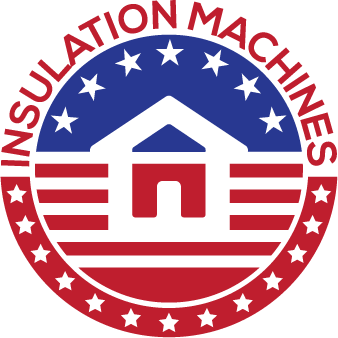Air Control Ball Valve: A valve place on the rear of the airlock to allow more control over the air pressure. These are necessary for machines that have a positive displacement blower where the air is not allowed a natural leak.
Airlock: A cylindrical chamber in which the loose fill material is injected into the air stream.
Airlock Seals: A set of seals attached to the spindle in the airlock. These seals create sections in the airlock that evenly distribute the material and allow the air stream to push the material through the hose.
Blower – Single Stage: This is the most basic blower which has one cylindrical vane.
Blower – 2 Stage: This has two cylindrical vanes that double the air volume.
Bridging: The undesirable effect when the mechanical arms designed to break up the insulation pushes the material back up into the hopper, creating an air cavity
Conditioning: The process of breaking apart pre-packaged/compressed fibers into consistent sizes with the proper amount of air, decompressing the material. This produces a consistent and interrupted flow of material.
Daisy Chain: Connecting two machines to the same hose to increase distance. With vacuums, two machines can be connected in the same hose line to allow you to go further distances in vacuuming. With insulation blowers, two machines can be joined to allow one machine to handle the dry material and the other machine to be the recovery machine for wet material.
Dense Packing: The method of installing insulation into a cavity (usually a wall cavity) with a pressure usually between 2.5 and 4.0 PSI.
Discharge Hose: The hose attached to the exit of the vacuum. This hose goes directly into a waste bin, trailer or a bag is attached at the end.
Dry Spray: The best phrase to describe stabilized wall spray. The material is slightly dampened with a vaporized water stream that activates the starch in the product and just enough water content to cause the material to adhere in the wall system.
Dual-Ply Airlock Seals: A rubber seal made with two layers of rubber glued together and strengthened by woven fabric.
Feed Gate: A steel plate with a graduated locking pin mechanism to control the amount of material being introduced into the airlock.
Generac Generators: Portable generators made in Wisconsin. Since 2008, Generac renetered the portable generator market.
Hardox® Liner: Hardox® is the brand name of wear-resistant steel used in extreme conditions. This is 3x harder than steel and used in industrial settings
Head Pressure: The amount of air pressure at the airlock.
Pressure Drop-off: The decreasing air pressure measured at the end of each section of hose. For every 50 feet of hose, you can expect a 5-10% decrease in air pressure.
Hopper: The container that sits on top of the machine into which you dump the fiber. Hoppers may be extended or split into two chambers for wall spray recycling.
Intake Hose: The hose that extends into the space where the debris is to be picked up.
Integrated Recycle Technology: A vacuum is incorporated into the blowing machine to recover debris-free wall spray. This vacuum recovery keeps the moist material separate from the dry material and meters the materials together to provide a consistent moisture to material combination.
Internal Wetting System: W water spray system that injects a fine mist of water to the material to eliminate dust clouds in the attic and stabilizes loose fill cellulose blown into the attic
PLC (Programmable Logic Controller): A computer that turns on and off relay outputs to make the machine run. Used by various insulation machine manufacturers. Cool Machines DOES NOT use PLCs. Only soft-start devices are used on the positive displacement blowers.
Pneumatic Tires: Air-filled, tubeless tires
Positive Displacement Blower: Think of a pump. It actually is. The rotors trap air, pushing it through. This creates a constant air movement which virtually eliminates clogging in the hose.
Positive Feeding System: This describes the process of moving the material forward instead of being blown back into the hopper.
Scalping Augers: Unique to the Cool Machine brand, these augers have short knives on the edge of the auger which aggressively shreds the fiber.
Seals (See Airlock Seals)
Slide Gate: A plate of steel used to meter the appropriate amount of material entering the airlock. This can be adjusted by 1″ increments.
Soft-Start: A device on generators and the positive displacement blower that prevents abrupt, hard torque when starting the motor. This eliminates the need for high voltage electrical starts
Turbine Housing: The chamber that surrounds the vacuum fan. The common name is “fan chamber.”
Turbo Shredder: Located above the airlock, this muti-toothed device separates the fiber into consistent, well-conditioned fibrous strands.
Vacuum Fan: The CoolMachine definition is an 18″ or 20″ diameter plate with continuous welded vanes, shaped with a curved tip to provide a turbo-effect.
Variable Speed: A dial is used to increase and decrease the amount of air being blown.
Wall Scrubber: A tool that is used to shave off the excess sprayed cellulose or fiberglass to an even plane matching the face of the studs
Wall Spray: The process of spraying stabilized loose-fill material into a vertical wall.
Water Column Inches: A measurement used to determine the force of air through a pipe. The greater the inches, the greater the force.
Wet Spray: A common, but wrong phrase for describing the proper stabilized wall spray. It implies a saturated material with high water content which would be a bad application
Winco Generators: Portable generators made in Minnesota. Since 1927, Winco has provided portable generators. These generators include gas and diesel options.
